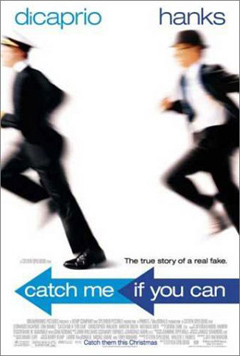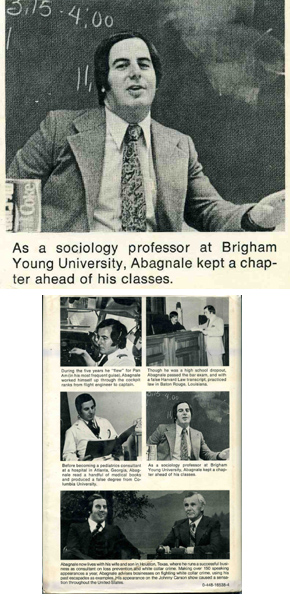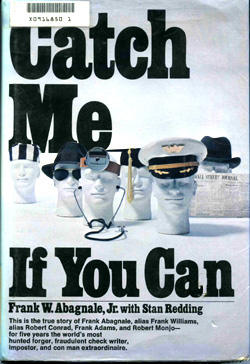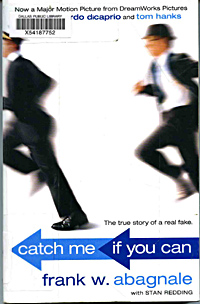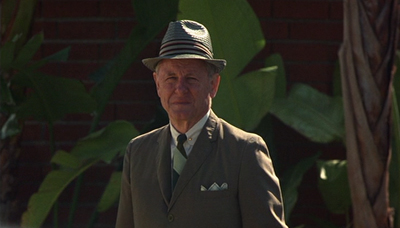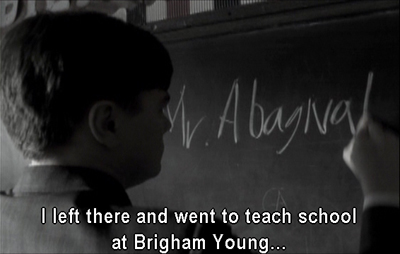In Frank Abagnale's autobiography he claims he was a sociology professor at
BYU for one year. The 1980 edition of the book has a photograph of him
ostensibly in his BYU classroom, with the caption "As a sociology professor
at Brigham Young University, Abagnale kept a chapter ahead of his classes."
Abagnale reiterates this claim in a featurette on the initial release of
"Catch Me If You Can" on DVD, a 2-disc DVD set distributed by DreamWorks
Home Entertainment and released in 2003. On disc 2, which contains the
special features, is a documentary extra feature titled
"Frank Abagnale: Between Reality and Fiction." In a sit-down interview, illustrated
by scenes from the movie and real photographs from his life, Abagnale outlines what he
actually did during his spree assuming various careers. The first chapter is
an introduction to him. The second chapter is about his time posing as a
airline pilot. The third chapter of this featurette is titled "Frank's
Careers." Abagnale's concluding narrration during this segment is as follows:
In an completely unrelated matter, Gerald R. Molen, the Latter-day Saint who produced so many of Spielberg's movies, has a brief cameo appearance in "Catch Me If You Can" as an FBI agent looking for Abagnale at the LAX airport.
The text below is from the movie tie-in edition, published in 2002 by Broadway Books (New York City, New York), pages 110 to 115:
Using the same procedures that had enabled me to assume the alias of Frank Williams, a first officer for Pan Am, I created Frank Adams, an alleged co-pilot for Trans World Airways, complete with uniform, sham ID and counterfeit FAA pilot's license. I also assembled a set of duplicitous credentials that would allow me, in my posture as Frank Williams, to be a pilot for either Pan Am or TWA.
Shortly afterward I was in Utah, a state notable for not only its spectacular geography and Mormon history but also for its proliferation of college campuses. Having purloined a couple of college degrees, I thought it only fair that I at least acquaint myself with a university campus and so I visited several Utah colleges, strolling around the grounds and taking in the academic sights, especially the coeds. There were so many lovely girls on one campus that I was tempted to enroll as a student.
Instead I became a teacher.
While I was tolling around my motel room one afternoon, reading the local newspaper, my attention was drawn to an expected shortage of summer instructors at one university. The news item quoted the faculty dean, one Dr. Amos Grimes, as being most concerned about finding summer replacements for the school's two sociology professor. "It appears we will have to look out of state for qualified people willing to teach for only three months," said Dr. Grimes in the story. A vision of myself ensconced in a classroom with a dozen or so nubile beauties took hold of my imagination, and I couldn't resist. I rang up Dr. Grimes.
"Dr. Grimes, Frank Adams here," I said briskly. "I have a Ph.D. in sociology from Columbia University in New York. I'm visiting here. Doctor, and I see by the newspaper that you're looking for sociology instructors."
"Yes, we're definitely interested in finding some people," Dr. Grimes replied cautiously. "Of course, you understand it would be only a temporary position, just for the summer. I assume you do have some teaching experience?"
"Oh, yes," I said airily. "But it's been several years. Let me explain my position, Dr. Grimes. I am a pilot for Trans World Airways, and just recently I was furloughed for six months for medical purposes, an inflammation of the inner ear that bars me at the moment from flying status. I've been looking around for something to do in the interim, and when I saw the story it occurred to me that it might be pleasant to get back into a classroom again.
"I was a professor of sociology at City College of New York for two years before I joined TWA."
"Well, it certainly sounds like you're a likely candidate for one of our positions, Dr. Adams," said Dr. Grimes, now enthusiastic. "Why don't you come by my office tomorrow morning and we'll talk about it."
"I'd be delighted to do that. Dr. Grimes," I. replied. "Since I'm a complete stranger in Utah, could you tell me what documents I will need to apply for a faculty position with your college?"
"Oh, just a transcript from Columbia will do, really," said
Dr. Grimes. "Of course, if you can obtain a couple of letters of recommendation from CCNY, it would be desirable."
"No problem," I said. "I'll have to send for both my transcript and the letters of recommendation, of course. I came here unprepared on either score, since I didn't even contemplate a temporary teaching position until I saw the story."
"I understand, Dr. Adams," replied Dr. Grimes. "I'll see you in the morning."
I wrote Columbia University that afternoon, requesting a complete catalogue and any pertinent brochures on the school. I also dashed off a letter to the registrar of CCNY, stating I was a Utah graduate student seeking a teaching position in New York, preferably in sociology. I arranged to rent a box at the local post office before mailing off the missives.
My meeting with Dean Grimes was a very pleasant one. He seemed immediately impressed with me, and we spent most of the time, including a leisurely luncheon interlude in the faculty club, discussing my "career" as a pilot. Dr. Grimes, like many men with sedentary jobs, had a romantic view of airline pilots and was eager to have his exciting perspective validated. I had more than enough anecdotes to satisfy his vicarious appetite.
"I have no doubt at all that we can use you this summer, Dr. Adams," he said on my departure. "I'm personally looking forward to your being here on campus."
The materials I had requested from Columbia and CCNY arrived within the week, and I drove to Salt Lake City to purchase the supplies necessary for my current counterfeiting venture. My finished "transcript" was a beauty, giving me a 3.7 grade average and listing my doctoral thesis as a dissertation on "The Sociological Impact of Aviation on the Rural Populations of North America." As I had anticipated, the reply from the registrar of CCNY was on official college stationery. I clipped off the letterhead and, using clear white plastic tape and high-quality bond paper, created a fine facsimile of the college's stationery. I trimmed it to regulation typewriter-paper size and then sat down and wrote myself two letters of recommendation, one from the registrar and one from the head of the sociology department.
I was cautious with both letters. They merely noted that I had been a sociology instructor at CCNY during the years 1961-62, that the faculty rating committee had given me very satisfactory marks and that I had resigned voluntarily to enter the field of commercial aviation as a pilot. I then took the letters to a Salt Lake City job printer and had him run off a dozen copies of each, telling him I was applying at several universities for a teaching position and thus needed extra copies on fine-grade bond. Apparently mine was not an unusual request, for he did the job perfunctorily.
Dr. Grimes barely glanced at the documents when I presented them to him. He introduced me to Dr. Wilbur Vanderhoff, assistant head of the sociology department, who also gave the instruments only a cursory examination before sending them on to faculty personnel for filing. I was hired within the hour to teach two six-week semesters during the summer at a salary of $1,600 per semester. I was assigned to teach a ninety-minute freshman course in the morning, three days a week, and a ninety-minute sophomore course in the afternoon, twice weekly. Dr. Vanderhoff provided me with the two textbooks to be used in the classes, as well as student attendance ledgers. "Any other supplies you might need, you can probably find in the bookstore. They have standard requisition forms on hand," said Dr. Vanderhoff. He grinned. "I'm glad to see you're young and strong. Our summer sociology classes are usually large ones, and you'll earn your salary."
I had three weeks before the first summer semester started. On the pretense of refreshing myself, I audited several of Dr. Vanderhoff's classes, just to get an idea of how a college course was conducted. At night I studied the two textbooks, which I found both interesting and informative.
Vanderhoff was right. Both my classes were large ones. There were seventy-eight students in my freshman class and sixty-three students in my sophomore course, the majority in both instances being female students.
That summer was one of the most enjoyable, of my life. I thoroughly enjoyed my role as a teacher. So did my students, I'm certain. My courses were taught by the book, as required, and I had no difficulty there. I just read one chapter ahead of the students and selected what portions of the text I wanted to emphasize. But almost daily I deviated from the textbook in both classes, lecturing on crime, the problems of young adults from broken homes and the effects on society as a whole. My departures from textbook contents -- which were largely drawn from my own experiences, unknown to the students -- always sparked lively discussions and debates.
Weekends I relaxed by immersing myself in one or the other of Utah's scenic wonderlands, usually accompanied by an equally wondrous companion.
The summer was gone as swiftly as the desert spring, and I knew real regret when it ended. Dr. Vanderhoff and Dr. Grimes were delighted with my work. "Keep in touch with us, Frank," said Dr. Grimes. "If ever we have a permanent opening for a sociology professor, we'd like a chance to lure you down from the skies," said Dr. Grimes.
At least fifty of my students sought me out to tell me how much they had enjoyed my classes and to wish me good-bye and good luck.
I was reluctant to leave that Utah Utopia, but I could find no valid reason for staying. If I lingered, my past was certain to catch up, and I did not want these people's image of me to be tarnished.
I headed west to California. There was a storm building in the Sierras when I crossed the mountains, but it was nothing compared to the whirlwind of crime I was soon to create myself.
